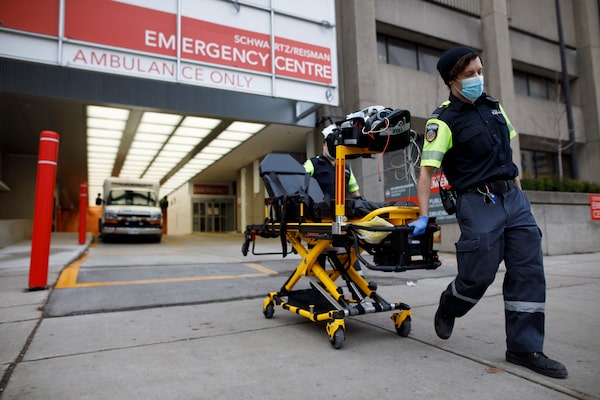
Paramedics wheel a gurney out from the emergency department at Mount Sinai Hospital in Toronto, Wednesday, Jan. 13, 2021.Cole Burston/The Canadian Press
A new Ontario study has found no increase in preterm or stillborn births during the first year of the COVID-19 pandemic.
The study, conducted by researchers at Mount Sinai Hospital and ICES (formerly the Institute for Clinical Evaluative Sciences), was published in the Canadian Medical Association Journal on Tuesday. After conflicting reports emerged for how the pandemic affected the rates of preterm births and stillbirths, Ontario researchers decided to determine whether these were true changes.
Their research found that the rates from the first year of the pandemic were consistent with a natural variation in preterm birth and stillbirth rates over the previous 17.5 years.
The study evaluated 2.4 million pregnancies involving people between the ages of 13 and 59 who delivered in any hospital in Ontario, using data from the Canadian Institute for Health Information’s Discharge Abstract Database. Researchers analyzed the preterm birth and stillbirth rates every six months from July, 2002, to December, 2020, and took the upper and lower control limits to account for natural variations in the rates. If the rates crossed those limits, then it would be an unusual variation.
“Preterm birth or stillbirth is not a fixed number every year,” said Prakesh Shah, pediatrician-in-chief at Mount Sinai Hospital and lead author on the study. “They fluctuate.”
Researchers calculated the mean preterm birth rate to be 7.96 per cent, ranging from 7.32 per cent to 8.59 per cent. They defined the pandemic year as between January to December, 2020, and the preterm birth rate for that period was within the range, at 7.87 per cent.
The mean stillbirth rate was 0.56 per cent, ranging from 0.48 per cent to 0.7 per cent. During the first year of the pandemic, the stillbirth rate was again within the range, at 0.53 per cent.
Researchers also compared the monthly rates over the past four years – the pandemic year, and then three years before – to see whether there was a difference in the rates of change of preterm birth or stillbirth over that time. Again, they found no significant increase or decrease in the rates of change.
The study analyzed data from pregnant people living in rural and urban regions. The mean stillbirth rates from both areas were the same, and within the natural variation range. Although the mean preterm birth rate was higher for pregnant people in urban regions than it was for those in rural regions, the rates were still within the natural variation range.
Researchers also found no unusual variation for either preterm birth or stillbirth rates in the four regions – Toronto, Peel, York and Ottawa – that had higher rates of COVID-19.
Similarly, researchers compared the mean rates by neighbourhood income levels, and found that all the rates remained within the natural variation range, though the rates of both preterm births and stillbirths decreased as the neighbourhood income increased.
Dr. Shah said the study should make people feel confident in Ontario’s health care system because it shows the province was able to properly care for pregnant people during the pandemic.
“I think it provides them with reassurance that there was no major impact of pandemic as far as pregnant people and their outcomes are concerned,” he said. “It reinforces that the overall system worked.”
Dr. Shah said contradictory reports of decreasing preterm births and increasing stillbirths during the pandemic came from individual medical centres, which doesn’t provide an accurate picture of trends. A downtown hospital, for instance, could report a decrease in preterm births because pregnant people might not have been visiting that hospital during the pandemic, and were rather choosing to visit medical centres closer to their homes.
Many of these studies also looked at a shorter time period, which doesn’t necessarily capture the variation year by year, Dr. Shah said. The CMAJ study, though, looked at data across Ontario over the previous 17.5 years in addition to the pandemic year, which provides a more holistic view, he added.
Medical centres in Denmark, the Netherlands, Ireland and the United States reported a decrease in preterm births, which some researchers have speculated was because of reduced stress related to improved work-life balance and less exposure to infections. Medical centres in Britain, Italy, Nepal and India reported an increase in stillbirths, which some researchers proposed was because of higher stress levels caused by the pandemic, financial challenges and reduced maternity services.
Researchers admit in the CMAJ study that they lacked case-level medical details to determine whether the reasons for preterm births or stillbirths during the pandemic differed compared with past years. The study also acknowledges that Ontario’s universal health care system has relatively few barriers to access care, and that the pandemic could have had different effects in various regions. Other studies are under way to understand the impact of COVID-19 on pregnancy and childbirth around the globe.
Our Morning Update and Evening Update newsletters are written by Globe editors, giving you a concise summary of the day’s most important headlines. Sign up today.